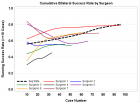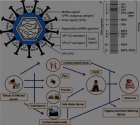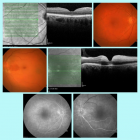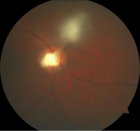Abstract
Retrospective Study
Patient, disease and surgeon predictors of successful bilateral sentinel lymph node mapping for endometrial cancer: A retrospective, multicenter analysis
Mary Towner, Kaylee Underkoffler, Anze Urh, Katina Robison and Richard G Moore*
Published: 14 July, 2022 | Volume 5 - Issue 3 | Pages: 072-079
Objective: Sentinel lymph node mapping is an acceptable standard for lymph node evaluation in patients with endometrial cancer. The purpose of this study was to evaluate the adoption of this technique at two academic institutions, including which patient and disease features are associated with rates of successfully identifying sentinel lymph nodes with fluorescent mapping. In addition, we sought to characterize if and how surgeons experience the technique related to successful bilateral sentinel lymph node mapping.
Methods: A retrospective chart review was performed of patients at two academic institutions who underwent sentinel lymph node mapping prior to a minimally invasive hysterectomy for endometrial cancer over the first 30 months during which the technique was adopted at each institution. A modified Poisson regression model was used to determine the relationships between patient, disease, and surgeon factors on outcomes of sentinel lymph node mapping.
Results: A total of 460 charts were reviewed. The mean age was 64 and the median body mass index was 34.2. The most disease was stage I (83%), endometrioid (89%), and Grade I (64%). The bilateral sentinel lymph node mapping success rate was 65%, while unilateral or bilateral success occurred in 91% of cases. Sentinel lymph node mapping was significantly more likely to be successful in premenopausal women (RR 1.25; 95% CI 1.07 - 1.46; p = 0.005) and Asian women (RR 1.48; 95% CI 1.3-1.68; p < 0.001). BMI was not significantly predictive of mapping success (RR 1.03; 95% CI 1.00 - 1.07; p = 0.05). Increasing surgeon experience with the technique did predict successful bilateral sentinel lymph node mapping (RR 1.02; 95% CI 1.00 - 1.03; p = 0.02).
Conclusion: Premenopausal status and surgeon experience with the technique increases the likelihood of bilateral sentinel lymph node detection for endometrial cancer.
Read Full Article HTML DOI: 10.29328/journal.cjog.1001111 Cite this Article Read Full Article PDF
Keywords:
PCOS; Phenotypes; Oocyte; Competence; Embryo
References
- Mikuta JJ. International Federation of Gynecology and Obstetrics staging of endometrial cancer 1988. Cancer. 1993 Feb 15;71(4 Suppl):1460-3. doi: 10.1002/cncr.2820710409. PMID: 8431880.
- Rossi EC, Kowalski LD, Scalici J, Cantrell L, Schuler K, Hanna RK, Method M, Ade M, Ivanova A, Boggess JF. A comparison of sentinel lymph node biopsy to lymphadenectomy for endometrial cancer staging (FIRES trial): a multicentre, prospective, cohort study. Lancet Oncol. 2017 Mar;18(3):384-392. doi: 10.1016/S1470-2045(17)30068-2. Epub 2017 Feb 1. PMID: 28159465.
- Bogani G, Murgia F, Ditto A, Raspagliesi F. Sentinel node mapping vs. lymphadenectomy in endometrial cancer: A systematic review and meta-analysis. Gynecol Oncol. 2019 Jun;153(3):676-683. doi: 10.1016/j.ygyno.2019.03.254. Epub 2019 Apr 2. PMID: 30952370.
- Tanner EJ, Sinno AK, Stone RL, Levinson KL, Long KC, Fader AN. Factors associated with successful bilateral sentinel lymph node mapping in endometrial cancer. Gynecol Oncol. 2015 Sep;138(3):542-7. doi: 10.1016/j.ygyno.2015.06.024. Epub 2015 Jun 19. PMID: 26095896.
- Tortorella L, Casarin J, Multinu F, Cappuccio S, McGree ME, Weaver AL, Langstraat CL, Keeney GL, Kumar A, Melis GB, Angioni S, Scambia G, Mariani A, Glaser GE. Sentinel lymph node biopsy with cervical injection of indocyanine green in apparent early-stage endometrial cancer: predictors of unsuccessful mapping. Gynecol Oncol. 2019 Oct;155(1):34-38. doi: 10.1016/j.ygyno.2019.08.008. Epub 2019 Aug 8. PMID: 31402166.
- Holloway RW, Abu-Rustum NR, Backes FJ, Boggess JF, Gotlieb WH, Jeffrey Lowery W, Rossi EC, Tanner EJ, Wolsky RJ. Sentinel lymph node mapping and staging in endometrial cancer: A Society of Gynecologic Oncology literature review with consensus recommendations. Gynecol Oncol. 2017 Aug;146(2):405-415. doi: 10.1016/j.ygyno.2017.05.027. Epub 2017 May 28. PMID: 28566221; PMCID: PMC6075736.
- Khoury-Collado F, Glaser GE, Zivanovic O, Sonoda Y, Levine DA, Chi DS, Gemignani ML, Barakat RR, Abu-Rustum NR. Improving sentinel lymph node detection rates in endometrial cancer: how many cases are needed? Gynecol Oncol. 2009 Dec;115(3):453-5. doi: 10.1016/j.ygyno.2009.08.026. Epub 2009 Sep 19. PMID: 19767064.
- Siegel RL, Miller KD, Jemal A. Cancer statistics, 2016. CA Cancer J Clin. 2016 Jan-Feb;66(1):7-30. doi: 10.3322/caac.21332. Epub 2016 Jan 7. PMID: 26742998.
- Morice P, Leary A, Creutzberg C, Abu-Rustum N, Darai E. Endometrial cancer. Lancet. 2016 Mar 12;387(10023):1094-1108. doi: 10.1016/S0140-6736(15)00130-0. Epub 2015 Sep 6. PMID: 26354523.
- Carlson JW, Kauderer J, Hutson A, Carter J, Armer J, Lockwood S, Nolte S, Stewart BR, Wenzel L, Walker J, Fleury A, Bonebrake A, Soper J, Mathews C, Zivanovic O, Richards WE, Tan A, Alberts DS, Barakat RR. GOG 244-The lymphedema and gynecologic cancer (LEG) study: Incidence and risk factors in newly diagnosed patients. Gynecol Oncol. 2020 Feb;156(2):467-474. doi: 10.1016/j.ygyno.2019.10.009. Epub 2019 Dec 16. PMID: 31837831; PMCID: PMC7018616.
- ASTEC study group, Kitchener H, Swart AM, Qian Q, Amos C, Parmar MK. Efficacy of systematic pelvic lymphadenectomy in endometrial cancer (MRC ASTEC trial): a randomised study. Lancet. 2009 Jan 10;373(9658):125-36. doi: 10.1016/S0140-6736(08)61766-3. Epub 2008 Dec 16. Erratum in: Lancet. 2009 May 23;373(9677):1764. PMID: 19070889; PMCID: PMC2646126.
- Hogberg T. Adjuvant chemotherapy in endometrial cancer. Int J Gynecol Cancer. 2010 Oct;20(11 Suppl 2):S57-9. doi: 10.1111/IGC.0b013e3181f749fd. PMID: 20975363.
- Rungruang B, Olawaiye AB. Comprehensive surgical staging for endometrial cancer. Rev Obstet Gynecol. 2012;5(1):28-34. PMID: 22582124; PMCID: PMC3349921.
- Mariani A, Dowdy SC, Cliby WA, Gostout BS, Jones MB, Wilson TO, Podratz KC. Prospective assessment of lymphatic dissemination in endometrial cancer: a paradigm shift in surgical staging. Gynecol Oncol. 2008 Apr;109(1):11-8. doi: 10.1016/j.ygyno.2008.01.023. Epub 2008 Mar 4. PMID: 18304622; PMCID: PMC3667391.
- Hamilton CA, Pothuri B, Arend RC, Backes FJ, Gehrig PA, Soliman PT, Thompson JS, Urban RR, Burke WM. Endometrial cancer: A society of gynecologic oncology evidence-based review and recommendations. Gynecol Oncol. 2021 Mar;160(3):817-826. doi: 10.1016/j.ygyno.2020.12.021. Epub 2021 Jan 27. PMID: 33516529.
- Soliman PT, Westin SN, Dioun S, Sun CC, Euscher E, Munsell MF, Fleming ND, Levenback C, Frumovitz M, Ramirez PT, Lu KH. A prospective validation study of sentinel lymph node mapping for high-risk endometrial cancer. Gynecol Oncol. 2017 Aug;146(2):234-239. doi: 10.1016/j.ygyno.2017.05.016. Epub 2017 May 18. PMID: 28528918; PMCID: PMC5860676.
- Vargiu V, Rosati A, Capozzi VA, Sozzi G, Gioè A, Berretta R, Chiantera V, Scambia G, Fanfani F, Cosentino F. Impact of Obesity on Sentinel Lymph Node Mapping in Patients with apparent Early-Stage Endometrial Cancer: The ObeLyX study. Gynecol Oncol. 2022 May;165(2):215-222. doi: 10.1016/j.ygyno.2022.03.003. Epub 2022 Mar 18. PMID: 35314087.
- Sozzi G, Fanfani F, Berretta R, Capozzi VA, Uccella S, Buono N, Giallombardo V, Di Donna MC, Monterossi G, Restaino S, Capasso I, Dinoi G, Scambia G, Chiantera V. Laparoscopic sentinel node mapping with intracervical indocyanine green injection for endometrial cancer: the SENTIFAIL study - a multicentric analysis of predictors of failed mapping. Int J Gynecol Cancer. 2020 Nov;30(11):1713-1718. doi: 10.1136/ijgc-2020-001724. Epub 2020 Aug 31. PMID: 32868384.
- Van Arsdale A, Miller DT, Kuo DY, Isani S, Sanchez L, Nevadunsky NS. Association of obesity with survival in patients with endometrial cancer. Gynecol Oncol. 2019 Jul;154(1):156-162. doi: 10.1016/j.ygyno.2019.03.258. Epub 2019 May 3. PMID: 31060820.
- Mundt AJ, Waggoner S, Yamada D, Rotmensch J, Connell PP. Age as a prognostic factor for recurrence in patients with endometrial carcinoma. Gynecol Oncol. 2000 Oct;79(1):79-85. doi: 10.1006/gyno.2000.5917. PMID: 11006036.
Figures:

Figure 1
Similar Articles
-
Effect of laparoscopic salpingectomy on subsequent ovarian response after controlled ovarian hyperstimulationChadi Yazbeck*,Asma Boukadida,Christian Chauvin,Anne Laure Margulies,Ségolène Falcone. Effect of laparoscopic salpingectomy on subsequent ovarian response after controlled ovarian hyperstimulation. . 2019 doi: 10.29328/journal.cjog.1001030; 2: 107-112
-
Intracerebral Hemorrhage of Brainstem in triple pregnancy after in vitro fertilization by receiving Ovum Donation: A case report and reviewAndreas Suhartoyo Winarno*,Lukas Schloesser,Frederic Dietzel,Percy Balan,Thomas Hoehn,Monika Hampl,Tanja Natascha Fehm. Intracerebral Hemorrhage of Brainstem in triple pregnancy after in vitro fertilization by receiving Ovum Donation: A case report and review. . 2019 doi: 10.29328/journal.cjog.1001037; 2: 138-144
-
COVID-19 in pregnancy: Our experience at a tertiary maternity unit in FranceDarido Jessie*,El Haddad Cynthia,Diari Jed,Grevoul Fesquet Julie,Bouzid Nassima,Bobric Andrea,Lakhdara Nefissa,Bazzi Zeinab,Lebis Cindy,Khadam Louay,Rigonnot Luc. COVID-19 in pregnancy: Our experience at a tertiary maternity unit in France. . 2020 doi: 10.29328/journal.cjog.1001051; 3: 054-064
-
Comparison of oocyte maturity rates in recombinant Human Chorionic Gonadotropin (HCG) and triptorelin acetate triggers: A prospective randomized studyLakshmanan S,Saravanan M,Senthil P*,Sharma N. Comparison of oocyte maturity rates in recombinant Human Chorionic Gonadotropin (HCG) and triptorelin acetate triggers: A prospective randomized study. . 2020 doi: 10.29328/journal.cjog.1001064; 3: 123-126
-
Effect of sperm DNA fragmentation on ICSI outcome: A prospective studySaravanan Lakshamanan,Saravanan Mahalakshmi,Harish Ramya,Sharma Nidhi*. Effect of sperm DNA fragmentation on ICSI outcome: A prospective study. . 2020 doi: 10.29328/journal.cjog.1001065; 3: 127-131
-
Endometrial thickness and frozen thaw embryo transfer: A prospective studyMahalakshmi S,Sakthi A,Saravanan L,Sharma Nidhi*. Endometrial thickness and frozen thaw embryo transfer: A prospective study. . 2020 doi: 10.29328/journal.cjog.1001066; 3: 132-135
-
Overview on current approach on recurrent miscarriage and threatened miscarriageBasant Sharma*,Jagat Deep,Chandrika Pandit,Bina Basnyat,Bandana Khanal,BB Raut,Brij Mohan Rajak,Deepak Patel,Rangina Laikangbam,Rajendra Basyal. Overview on current approach on recurrent miscarriage and threatened miscarriage. . 2020 doi: 10.29328/journal.cjog.1001070; 3: 151-157
-
Unilateral pleural effusion as the sole presentation of ovarian hyperstimulation syndrome (OHSS)Tarique Salman*,Suruchi Mohan,Yasmin Sana. Unilateral pleural effusion as the sole presentation of ovarian hyperstimulation syndrome (OHSS). . 2020 doi: 10.29328/journal.cjog.1001074; 3: 182-184
-
Epidemiologic aspects and risk factors associated with infertility in women undergoing assisted reproductive technology (ART) in north of IranMarzieh Zamaniyan,Noushin Gordani*,Paniz Bagheri,Kaveh Jafari,Sepideh Peyvandi,Mojtaba Hajihoseini,Robabeh Taheripanah,Siavash Moradi,Salomeh Peyvandi,Arman Alborzi. Epidemiologic aspects and risk factors associated with infertility in women undergoing assisted reproductive technology (ART) in north of Iran. . 2021 doi: 10.29328/journal.cjog.1001079; 4: 015-018
-
A Genetic study in assisted reproduction and the risk of congenital anomaliesKaparelioti Chrysoula,Koniari Eleni*,Efthymiou Vasiliki,Loutradis Dimitrios,Chrousos George,Fryssira Eleni. A Genetic study in assisted reproduction and the risk of congenital anomalies. . 2021 doi: 10.29328/journal.cjog.1001095; 4: 096-100
Recently Viewed
-
Non-surgical Treatment of Verrucous Hyperplasia on Amputation Stump: A Case Report and Literature ReviewSajeda Alnabelsi*, Reem Hasan, Hussein Abdallah, Suzan Qattini. Non-surgical Treatment of Verrucous Hyperplasia on Amputation Stump: A Case Report and Literature Review. Ann Dermatol Res. 2024: doi: 10.29328/journal.adr.1001034; 8: 015-017
-
Outpatient operative hysteroscopy: evaluation of patient satisfaction and acceptanceClare Margaret Crowley*,Noelle Gill,Minna Geisler. Outpatient operative hysteroscopy: evaluation of patient satisfaction and acceptance. Clin J Obstet Gynecol. 2022: doi: 10.29328/journal.cjog.1001098; 5: 005-008
-
Predictors of positive treatment response to PTNS in women with overactive bladderSuneetha Rachaneni*,Doyo Enki,Megan Welstand,Thomasin Heggie,Anupreet Dua. Predictors of positive treatment response to PTNS in women with overactive bladder. Clin J Obstet Gynecol. 2022: doi: 10.29328/journal.cjog.1001097; 5: 001-004
-
Prediction of neonatal and maternal index based on development and population indicators: a global ecological studySedigheh Abdollahpour,Hamid Heidarian Miri,Talat Khadivzadeh*. Prediction of neonatal and maternal index based on development and population indicators: a global ecological study. Clin J Obstet Gynecol. 2021: doi: 10.29328/journal.cjog.1001096; 4: 101-105
-
A Genetic study in assisted reproduction and the risk of congenital anomaliesKaparelioti Chrysoula,Koniari Eleni*,Efthymiou Vasiliki,Loutradis Dimitrios,Chrousos George,Fryssira Eleni. A Genetic study in assisted reproduction and the risk of congenital anomalies. Clin J Obstet Gynecol. 2021: doi: 10.29328/journal.cjog.1001095; 4: 096-100
Most Viewed
-
Evaluation of Biostimulants Based on Recovered Protein Hydrolysates from Animal By-products as Plant Growth EnhancersH Pérez-Aguilar*, M Lacruz-Asaro, F Arán-Ais. Evaluation of Biostimulants Based on Recovered Protein Hydrolysates from Animal By-products as Plant Growth Enhancers. J Plant Sci Phytopathol. 2023 doi: 10.29328/journal.jpsp.1001104; 7: 042-047
-
Sinonasal Myxoma Extending into the Orbit in a 4-Year Old: A Case PresentationJulian A Purrinos*, Ramzi Younis. Sinonasal Myxoma Extending into the Orbit in a 4-Year Old: A Case Presentation. Arch Case Rep. 2024 doi: 10.29328/journal.acr.1001099; 8: 075-077
-
Feasibility study of magnetic sensing for detecting single-neuron action potentialsDenis Tonini,Kai Wu,Renata Saha,Jian-Ping Wang*. Feasibility study of magnetic sensing for detecting single-neuron action potentials. Ann Biomed Sci Eng. 2022 doi: 10.29328/journal.abse.1001018; 6: 019-029
-
Pediatric Dysgerminoma: Unveiling a Rare Ovarian TumorFaten Limaiem*, Khalil Saffar, Ahmed Halouani. Pediatric Dysgerminoma: Unveiling a Rare Ovarian Tumor. Arch Case Rep. 2024 doi: 10.29328/journal.acr.1001087; 8: 010-013
-
Physical activity can change the physiological and psychological circumstances during COVID-19 pandemic: A narrative reviewKhashayar Maroufi*. Physical activity can change the physiological and psychological circumstances during COVID-19 pandemic: A narrative review. J Sports Med Ther. 2021 doi: 10.29328/journal.jsmt.1001051; 6: 001-007

HSPI: We're glad you're here. Please click "create a new Query" if you are a new visitor to our website and need further information from us.
If you are already a member of our network and need to keep track of any developments regarding a question you have already submitted, click "take me to my Query."
















































































































































